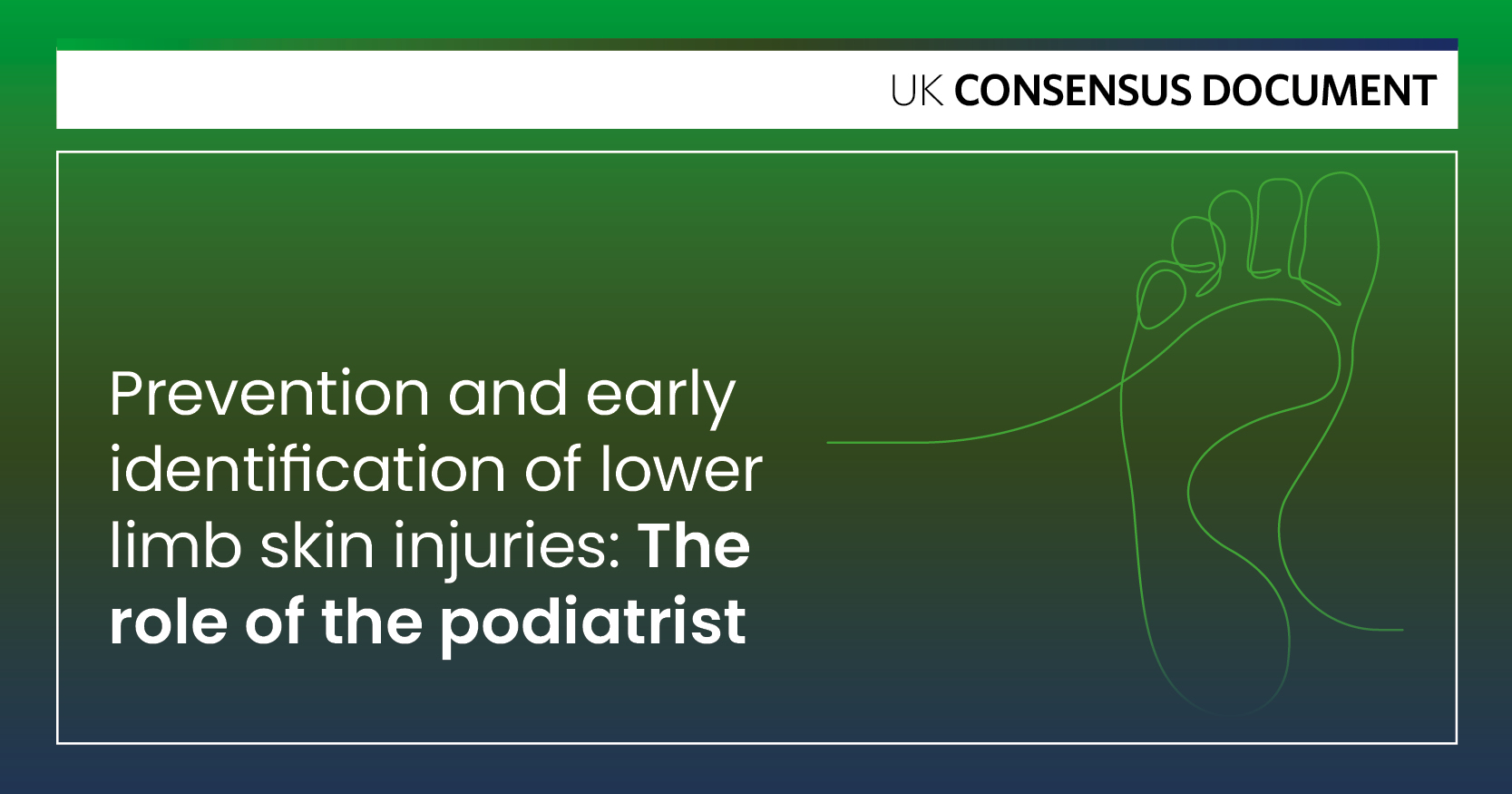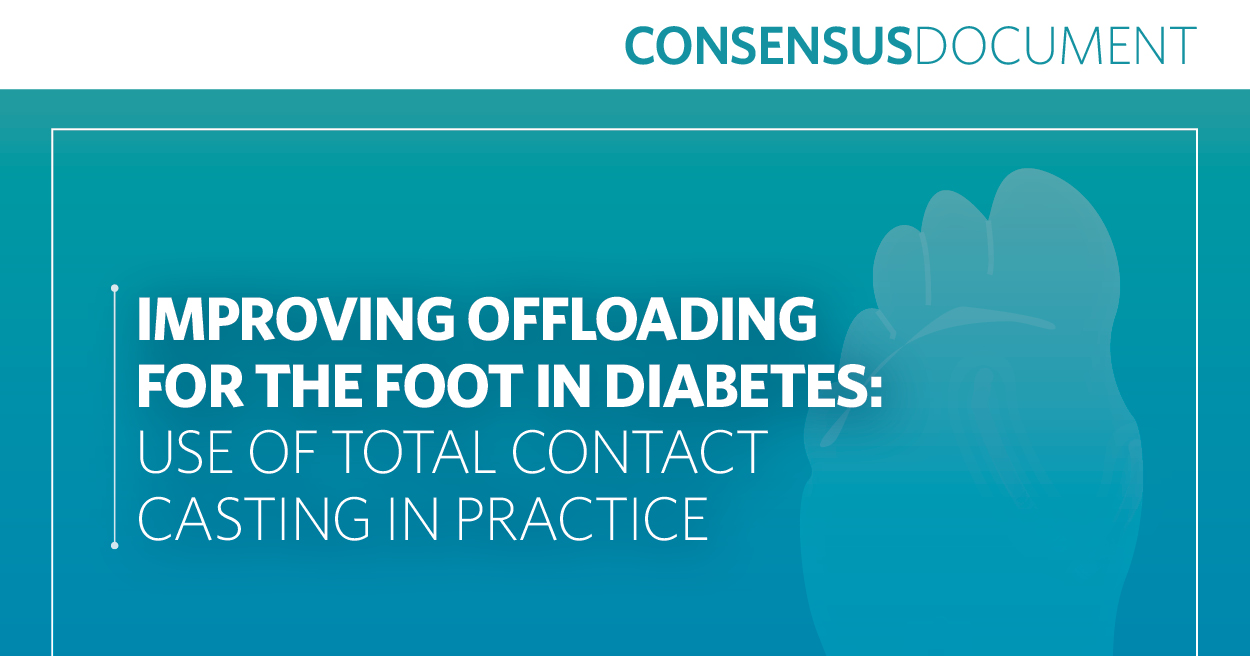Diabetes predisposes people with the condition to a range of systemic pathologies. These typically present approximately 20 years after diagnosis in people with type 1 diabetes, but around 10 years post-diagnosis in those with type 2 diabetes (Giligor and Lazarus, 1981), or may even precede and inform a type 2 diabetes diagnosis (Diabetes UK, 2004).
In addition to the widely known late-stage complications of diabetes (vasculopathy, nephropathy, retinopathy, polyneuropathy) the majority of people with diabetes also develop disease-related skin complications over the course of their condition (Wahid and Kanjee, 1998; Mahajan et al, 2003; Nigam and Pande, 2003; Van Hattem et al, 2008; Wani et al, 2009).
Dermatological problems in diabetes occur as a result of abnormal carbohydrate metabolism, accumulation of advanced glycation end-products (AGEs) in soft tissues and joint ligaments, limb atherosclerosis (macroangiopathy), dermal microangiopathy, limb and dermal neurone degeneration and impaired immune mechanisms (Jennifer and John, 2003; Wani et al, 2009).
Background
Dermatological conditions are significant in the context of diabetes for a number of reasons (Shemer et al, 1998; Bhat et al, 2006; Ayub et al, 2009). Skin changes may be:
- Diagnostic of diabetes or insulin resistance. For example, diabetic dermopathy, necrobiosis lipoidica diabeticorum (NLD), diabetic bullosis, and eruptive xanthomatosis tend to affect only people with diabetes. Lichen planus (LP), NLD and acanthosis nigricans (AN) are more common in people who subsequently go on to develop diabetes or show current insulin resistance. Individuals with type 1 diabetes tend to develop autoimmune-related skin lesions such as vitiligo and LP, whereas those with type 2 diabetes are more prone to develop bacterial and fungal skin infections (Table 1).
- Indicative of worsening glycaemic control or progression to a range of diabetes-related complications, with one in 20 people with diabetes-related skin lesions also having diabetic nephropathy, neuropathy or retinopathy (see Appendix I).
- Adverse reactions to antidiabetes drugs (e.g. erythema multiforme assocaiated with metformin use [Burger and Goyal, 2004]), or reactions to the administration of those drugs (e.g. insulin therapy [Richardson and Kerr, 2003]); and
- Progress to life- and/or limb-threatening infection and/or ulceration in the foot or lower limb.
Clinical examination
The risks associated with skin breakdown and ulceration in the diabetic lower limb are great. For this reason a clinical examination must review all aspects of the skin of the lower leg and foot for ulceration, joint deformity, discoloration, erythema, corn and/or callosity, haemorrhagic callus, interdigital maceration, infection and nail dystrophies (Boulton et al, 2008). Overall skin texture should be assessed, and evidence of oedema, dyshidroses, fissures or tinea pedis noted (Bristow, 2008). Nails should be examined for dystrophy, involution, paronychia, and onychomycosis. Neurological and vascular integrity should be tested, the skin temperature recorded, especially noting any differences between one foot and the other: a hotter foot may indicate infection, underlying active Charcot neuroarthropathy or skin inflammation indicative of possible ulceration, while a cold foot may indicate peripheral ischaemia (McGee and Boyko, 1998; Lavery et al, 2004; Armstrong et al, 2007; Lavery et al, 2007).
Angiopathy and neuropathy: clinical signs in the skin
Skin signs of macrovascular disease – otherwise known as peripheral vascular disease – include cold superficial tissue, hair loss, nail dystrophy and soft tissue atrophy in the foot, skin pallor on limb elevation and mottling and cyanosis with limb dependency and, in its ultimate form, ischaemic ulceration (Figure 1a) and distal gangrene.
Microvascular disease caused by arterio-venous shunting, capillary basement membrane thickening, glycation of erythrocyte membranes and increased plasma viscosity induces generalised compromise of capillary circulation with resultant reduced superficial tissue viability, patchy tissue necrosis and neuropathy (Figure 1b).
Reduced capillary function also causes erysipelas-like erythema (cold red skin of the foot) or microvenular dilatation, noted as facial flushing, periungual telangectasias and plantar erythema (Figure 1c). Extravasated erythrocytes from compromised capillaries cause pigmented purpura, or “cayenne pepper spots” (Figure 1d) of anterior tibial and dorsal foot skin, especially in older people with diabetes.
Distal polyneuropathy causes anhidrosis (Figure 1a), skin fissures and arteriovenous shunting (secondary to autonomic dysfunction), hyperkeratosis and trophic ulceration (with sensory loss) in areas of excess plantar pressure within the diabetic “claw foot”, itself due to motor neuropathy and loss of joint mobility (Huntley and Drugge, 2009).
Non-ulcerative skin pathologies of the diabetic lower limb
The above text has summarised some of the dermatological effects of the systemic complications of diabetes within the lower limb that are all too familiar to the healthcare professional involved in the care of the person with diabetes and the diabetic foot. The remainder of this article will focus on some of the non-ulcerative skin pathologies, seen primarily within the foot and lower limb, that are strongly associated with diabetes.
Acquired perforating dermatosis (Kyrle’s disease)
Acquired perforating dermatosis is rare. It typically affects people with renal failure, is noted in 10% of those on renal dialysis and can occur in diabetes. Lesions present as 2–10mm diameter, pruritic, dome-shaped nodules with a central hyperkeratotic plug, mainly on the limbs, but also on the trunk, dorsa of the hands, and sometimes the face. Lesions show the Koebner phenomenon, and readily ulcerate if scratched.
Healing occurs within several months if lesion trauma can be avoided. Treatments such as topical keratolytics, psoralens with ultraviolet-A light, ultraviolet-B light, topical and systemic retinoids, topical and intralesional steroids, oral antihistamines and cryotherapy, are suggested (Morton et al, 1996; Ferringer and Miller, 2002; Saray et al, 2006).
Bullous disease of diabetes (diabetic bullae; bullosis diabeticorum)
Bullous disease of diabetes (Figure 2) is characterised by marked blister formation of foot and leg skin in people with long-standing diabetes (Junkins-Hopkins, 2009), distal sensory neuropathy and nephropathy (Chakrabarty et al, 2002), independent of quality of glycaemic control (Ghosh et al, 2009). It is a putative cause of neuropathic foot ulcers and affects 1% of people with diabetes, with a 2:1 male:female ratio and a wide age range of onset (Larsen et al, 2008).
Blisters that are characteristically large (several centimetres in diameter), tense and irregular in outline form as intra-epidermal clefts filled with clear fluid; more unusually, haemorrhagic blisters form at the dermo–epidermal junction (Chakrabarty et al, 2002). Surrounding skin shows little or no inflammation. The differential diagnosis should exclude other causes of blisters (Ghosh et al, 2009).
Treatment is straightforward, involving protection of affected skin areas until lesions resolve. Very tense blisters may require aspiration, compression dressings and possible topical antibiotics. Blisters usually heal spontaneously without scarring within 2–3 weeks, unless subdermal tissues become involved or infection supervenes.
Diabetic dermopathy
Diabetic dermopathy (DD; “shin spots”; Figure 3) is the most common diabetic dermal pathology, affecting 7–70% of people with diabetes (Shemer et al, 1998), and preceding other signs of abnormal glucose metabolism. There is a close association between DD and severe systemic microvascular complications (Ferringer and Miller, 2002), indicating the likelihood of secondary diabetes-related complications (Sibbald et al, 1996).
Typically, DD affects men more than women, presenting as bilateral, round-to-oval, asymmetrical hyperpigmented patches of pretibial, lateral malleolar and dorsal foot skin (Van Hattem et al, 2008). Lesions are characterised by dermal oedema and local extravasation of erythrocytes (Binkley et al, 1967; Bauer and Levan, 1970) that break down in situ leaving haemosiderin deposits, which cause the characteristic irregular, blotchy, brownish skin pigmentation. Early DD skin changes do not cause marked symptoms, but the characteristic hyperpigmentation persists (Jelinek, 1994).
Diabetic thick skin
People with diabetes tend to develop stiffer skin with increasing diabetes duration, especially those with type 1 diabetes (Brik et al, 1991). Skin stiffness occurs as an increase in skin thickness, and/or scleroderma-like changes with associated reduced foot, hand and digit mobility (Huntley and Walter, 1990), “pebbling” of knuckle skin (Libecco and Brodell, 2001), diabetic hand syndrome (inability to extend the wrists and flatten the palms), DuPuytren’s contracture (Huntley, 1982), reduced or absent subtalar joint motion (Delbridge et al, 1988) and sensory neuropathy (Van Hattem et al, 2008).
Causes of stiff skin include hydration of dermal collagen and generalised non-enzymatic glycosylation of dermal collagen with accumulation of AGEs within soft tissues (Buckingham et al, 1984; Perez and Kohn, 1994; Hashmi et al, 2006). There is no treatment for the condition, although strict glycaemic control appears to be of some benefit (Lieberman et al, 1980).
Granuloma annulare
Granuloma annulare (GA; Figure 4) is a relatively common dermal pathology characterised by asymptomatic papules and annular plaques, often of sun-exposed skin areas precipitated or exacerbated by chronic stress or triggered by certain drug regimens.
GA shows familial incidence, occurs in all races and age groups, although is rare in infancy (Cyr, 2006), and younger women are more commonly affected (female:male ratio 2:1; Kakourou et al, 2005). As many as one in eight people with type 1 diabetes develop GA (Studer et al, 1996). It also occurs in type 2 diabetes (Ghadially et al, 2009), developing at an earlier stage of the condition’s natural history than NLD (Davison et al, 2010). GA has a weak association with underlying lymphoma (Li et al, 2003) and the differential diagnosis should exclude sarcoidosis (Cyr, 2006).
GA lesions vary in form and appearance. Initially, erythematous 1–2mm papules form (in dorsal foot and extensor lower leg skin); these gradually coalesce into arcs or annular plaques up to 5cm in diameter with depressed hyperpigmented centres. A more generalised form may cause widespread leg and plantar skin involvement. A subcutaneous form presents as solitary, firm, non-tender, skin-coloured or pinkish isolated nodules attached to underlying fascia of pretibial and dorsal skin (Argent et al, 1994). A perforating form causes lower limb ulceration and later scarring, especially in older people (Penas et al, 1997).
GA lesions improve in winter and worsen in summer, and usually resolve spontaneously within 2–24 months of onset (Cyr, 2006).
Yellow skin and nails
Yellowing of the nails and plantar skin is seen in diabetes, especially in older people with type 2 diabetes. The discoloration is non-significant, and appears to be due to the long-term accumulation of carotene and AGEs within skin and nail tissue (Perez and Kohn, 1994; Norman, 2001). It is most marked in the hallux nail and weight-bearing parts of the plantar surface, especially in areas of hyperkeratosis.
Cutaneous infections
People with well-controlled diabetes are no more susceptible to infections than the normal population. However, those with poor glycaemic control, reduced tissue perfusion and microangiopathy, generalised peripheral vascular disease, peripheral neuropathy, and the decreased immune response that characterises diabetes are especially prone to systemic and skin infections (Perez and Kohn, 1994; Norman, 2001).
Bacterial infections
As the acute inflammatory response is reduced in diabetes, signs of impending or current bacterial infection with Staphylococcus aureus and beta-haemolytic streptococci, causing skin and superficial tissue infections, such as cellulitis and necrotising fasciitis, are masked. Antibiotic therapy is usually required.
People with poorly controlled diabetes are more prone to anaerobic infections (e.g. Clostridium species). These require urgent, aggressive intervention and intravenous antibiotic therapy to prevent subsequent limb amputation. Pseudomonas readily colonises interdigital spaces or contaminates existing skin wounds or fissures.
People who are obese and have diabetes are especially susceptible to erythrasma, caused by Corynebacterium minutissimum infection (Meurer and Szeimies, 1991), presenting in the foot as inflamed, pustular skin areas or pruritic interdigital fissures that resemble tinea or candidal infection. Erythrasma is confirmed by coral pink fluorescence under ultraviolet (Wood’s) light and treated with topical or systemic erythromycin (Ferringer and Miller, 2002; Morales-Trujillo et al, 2008; Huntley and Drugge, 2009).
Fungal infections
Genital or oral thrush due to Candida (yeast; monilia) infection indicates poorly controlled or undiagnosed diabetes (Norman, 2001) and is often the pre-diagnostic presenting symptom (Lugo-Somolinos and Sánchez, 1992). Candidal infections within the feet frequently cause web-space intertrigo with web spaces showing marked inflammation, peeling and maceration, painful, raw apposing surfaces, with serous discharge, crusting and a characteristic yeasty smell, paronychia (marked nail-fold inflammation, swelling, tenderness, separation of the eponychium from the nail plate, and resultant nail plate dystrophy) or nail plate infection (the nail becomes white, friable and dystrophic). Treatment includes normalisation of blood glucose together with topical antifungal medications (e.g. topical imidazoles or 1% terbinafine; Meurer and Szeimies, 1991).
Dermatophyte infections (tinea pedis) of foot skin or nails caused by Epidermophyton floccosum, Trichophyton rubrum or T. mentagrophytes present as mildly inflamed, pruritic areas with peeling and parakeratosis of plantar skin (Figure 5a) and maceration and fissuring of interdigital skin (Figure 5b). Perimeter heel skin shows frank hyperkeratosis and marked fissuring, extending into non-weight bearing heel skin as chronically inflamed areas of scaling and parakeratosis (Figure 5c). Nail infections present as white superficial onychomycosis, or as intermediate nail plate involvement causing white, yellow or brown discoloration, dystrophy and friability of all or part of the nail plate and matrix (Figure 5d).
People with poorly controlled diabetes may also be prone to more rare fungal infections such as Phycomycetes (Van Hattem et al, 2008).
As fungal infections, especially in skin, predispose to secondary bacterial infection, they should be monitored and treated with fungicidal preparations, such as terbinafine (topical 1% cream, or systemically), especially in people with coexisting neurovascular compromise or intertrigo.
Lichen planus
LP (Figure 6) is an intensely itchy (pruritic), chronic inflammatory disease of skin and/or mucous membranes characterised by crops of shiny, violaceous, polygonal papules, varying from 1 mm to >1 cm in diameter, covered by a fine parakeratotic scale (Wickham’s striae). Lesions form as a delayed hypersensitivity immunological reaction, causing local inflammation and keratinocyte destruction (Neimann et al, 2006; Dreiher et al, 2008).
Cutaneous LP most commonly affects the flexor surfaces of limbs, although a chronic, pruritic, hypertrophic presentation may affect ankle skin and the extensor surfaces of the legs. Skin lesions may be discrete or arranged in lines or circles, showing the Koebner effect. Ten per cent of those affected also show related nail dystrophies (Chuang and Stitle, 2010).
In the majority of cases, skin lesions resolve within 6–18 months of onset, but affected skin areas show a characteristic slow-to-fade local hyperpigmentation.
LP affects approximately 1% of the adult population, although it can occur at any age (Balasubramaniam et al, 2008). People with LP show an increased prevalence of diabetes, insulin resistance and metabolic syndrome (i.e. high blood pressure, carbohydrate intolerance and dyslipidaemia). Onset is often stress related (Manolache et al, 2008) and those affected may also develop other immune-related diseases, for example vitiligo, alopecia, myasthenia gravis, pernicious anaemia or hepatitis C infection (Powell et al, 1974; Lowe et al, 1976; Dreiher et al, 2008; Bigby, 2009).
Necrobiosis lipoidica diabeticorum
NLD (Figure 7), particularly of pretibial skin, is a marker lesion for diabetes and its systemic complications (e.g. nephropathy and retinopathy; Kelly et al, 1993). Although only 1% of people with diabetes develop NLD, more than half of cases occur in those with diabetes (Cohen et al, 1996). Many people with diabetes show NLD lesions before diabetes diagnosis, and a quarter develop lesions soon after disease onset (Perez and Kohn, 1994).
Lesions typically develop in relation to mild trauma, ulcerate readily if subjected to ongoing trauma, and are more common in women than men, and in type 1 than type 2 diabetes (Meurer and Szeimies, 1991; Petzelbauer et al, 1992; Perez and Kohn, 1994; Marinella, 2002; Ahmed and Goldstein, 2006).
NLD occurs as chronic inflammatory degeneration of skin collagen. Initially lesions form as well-circumscribed, ovoid, sometimes pruritic, erythematous plaques several centimetres in diameter, which fade over time to form insensate depressed, waxy areas of atrophic epidermis through which enlarged dermal vessels (telangectasia) may be visible.
The exact cause of the disease is unknown, but poor glycaemic control (Cohen et al, 1996), abnormal cytokine production, diabetic microangiopathy (Kelly et al, 1993) and an abnormal inflammatory response in association with distal sensory neuropathy (Barnes and Davis, 2010) are implicated in lesion genesis.
Treatment options include tight glycaemic control (Cohen et al, 1996), systemic non-steroidal anti-inflammatory agents, systemic, intralesional or topical corticosteroids (Ferringer and Miller, 2002) and topical immunosuppressive drugs (Nguyen et al, 2002; Stanway et al, 2004; Ahmed and Goldstein, 2006).
Pruritus
Pruritus (chronic skin irritation) complicates diabetes-related chronic renal failure and renal dialysis (Etter and Myers, 2002), but not acute renal failure. Apart from the ongoing discomfort of the condition, constant scratching traumatises skin, predisposing to secondary infection and skin ulceration.
Of unknown causes, pruritus is strongly associated with low urine output (<500 mL/24 hours; Bencini et al, 1985;
Picó et al, 1992) and the accumulation of metallic ions and histamine (Weisman and Graham, 1998) that is characteristic of reduced renal function.
Conclusion
Diabetes currently consumes 5% of the NHS budget, although only 3.5% of the English population has the condition (NHS Information Centre, 2006). The type 2 presentation (90% of diabetes cases) is predicted to increase ten-fold by 2030 (Bagust et al, 2002), and 50% of these cases will already have secondary complications at diagnosis (Diabetes UK, 2004).
Indicators, such as skin changes and dermatological pathologies, that alert the clinician to impending diabetes or the onset of underlying or unsuspected secondary systemic complications of diabetes, form a vital part of early disease recognition. Recognition and appropriate management of diabetes-related dermatological pathologies of the foot and lower limb are of special importance in that their diagnosis and careful management may prevent progression to ulceration and infection, which are themselves strongly linked to increased morbidity and mortality (Davis et al, 2006).





